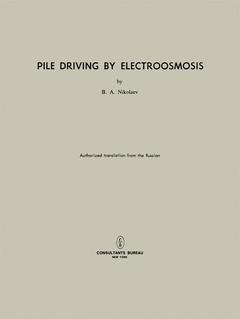Pile Driving by Electroosmosis, 1962
Langue : Anglais
Auteur : Nikolaev B. A.

In the seven-year plan for development of the national economy of the USSR, bridge construction and the build ing of hydrotechnical structures occupy a prominent place. One of the most importa. nt operations in such construc tion is the laying of pile foundations. In recent years deep pile foundations have been developed, with heavy loads on the piling. This technique is necessary when penetrating dense sand-clay soils or when sinking the piles to hard rock. The operations are very laborious, requiring a. great expenditure of time and effort, and this Significantly low ers the time of productive work (actual driving of piles) and reduces the quality of the work. To improve the efficiency of pile driving under such conditions, it is desirable to use electroosmosis. By elec troosmosis we refer to the movement of pore water through the ground, directed from anode to cathode under the in fluence of direct current. This current, in passing through clayey sOils, causes drying of the soil at the anode and moistening of the soil at the cathode. Therefore, if a pile that is to be driven is connected to the negative terminal of a. direct-current generator, electroosmosis will cause a film of moisture from the soil to settle on the surface of the pile, and a zone of electroosmotically water-saturated soil will form about the pile. This situation permits a temporary diminution of the resistance of the ground to the sinking of the pile.
I. Phenomena Originating in Ground while Sinking Piles by Electroosmosis.- 1. Electroosmosis and Electrolysis in Clay Ground.- 2. The Effect of Direct Current on the Resistance of the Ground to Sinking of a Pile-Cathode.- II. The Influence of Mineral Composition and Physical Properties of the Ground on the Effectiveness of Sinking Piles by Electroosmosis.- 3. Methods of Investigation and Characteristics of the Ground.- 4. Results of Experimental Tests.- III. The Effect of Area of Electrodes on Rate of Driving Wooden Piles.- 5. Laboratory Investigations.- 6. Experiments under Field Conditions.- IV. Driving Steel Piles by Electroosmosis.- 7. Effectiveness of the Electroosmotic Method of Driving Piles under the Geologic Conditions of the Experimental Setup.- 8. The Effect of Changes in Voltage, Current, and Current Density on the Rate of Sinking Steel Piles.- 9. The Effect of Rate of Driving Steel Piles and the Effect of Distance between Pile-Electrodes on the Acceleration of Sinking by Means of Electroosmosis.- V. Driving and Vibrosinking Reinforced-Concrete Tubular Piles by Electroosmosis.- 10. Investigations on an Experimental Stand.- 11. Application of the Electroosmotic Method of Accelerating the Sinking of Reinforced-Concrete Tubular Piles for the Stoitel’ Bridge in Leningrad.- VI. Restoration of Bearing Capacity of Piles after Electroosmotic Driving.- 12. Results of Dynamic and Static Tests on Piles.- VII. An Approximate Method of Computing the Parameters of Direct Current, Optimum Penetration per Blow, and Area of Electrodes..- 13. Computing the Parameters of Current and the Optimum Penetration per Blow for Steel Piles.- 14. Computing the Parameters of Current and Optimum Area of Electrodes for Nonmetallic Piles.- VIII. Practical Recommendations for the Electroosmotic Method of Accelerating Pile Driving.- 15. Geologic Conditions Favorable for Driving Piles by Electroosmosis.- 16. Arrangement of the Electrodes.- 17. Measures for Eliminating Leakage of Direct Current.- 18. The Operation of Pile Driving by Electroosmosis.- 19. Experimental Work on Sinking and Testing Piles -.- 20. Data on the Economy in Time and Electrical Energy when Driving Piles by Electroosmosis.- 21. Some Potential Future Uses of Electroosmosis in the Field of Foundation Construction.- References.
Date de parution : 05-2012
Ouvrage de 62 p.
21x27.9 cm
Disponible chez l'éditeur (délai d'approvisionnement : 15 jours).
Prix indicatif 52,74 €
Ajouter au panier
© 2024 LAVOISIER S.A.S.


